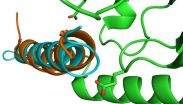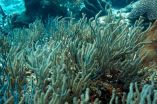(Press-News.org) A genetic misfire called the 3q26.2 amplicon can cause real havoc. In fact, it is among the most frequent chromosomal aberrations seen in many cancers, including ovarian and breast cancers.
Researchers behind a study at The University of Texas MD Anderson Cancer Center believe they may have found a molecule-based approach to halting 3q26.2's destructive nature. By manipulating a non-coding microRNA (miRNA) known as miR569 that is part of the amplicon, scientists were able to increase cell death in vitro and in vivo. MicroRNAs are short, non-coding RNA molecules that are important to controlling gene expression.
The study was featured in this month's issue of Cancer Cell.
"Small non-coding miRNAs represent underexplored targets of genetic aberrations and emerging therapeutic targets," said study lead Gordon Mills, M.D., Ph.D., professor and chair of Systems Biology at MD Anderson. "We demonstrated that miR569, which is overexpressed in a subset of ovarian and breast cancers due in part to the 3q26.2 amplicon, can impact cell survival and proliferation."
In order for miR69 to halt 3q26.2's penchant for molecular mayhem, it must first alter expression levels of the tumor protein known as TP53INP1.
"The study results clearly show that TP53INP1 is a key target of miR569 both in vitro and in vivo," said Mills. "An increase in miR569 levels subsequently decreased TP53INP1 levels which was associated with worsened outcomes for ovarian patients."
However, when miR569 expression was "silenced" or decreased, TP53INP1 levels were increased and survivability outcomes improved. In effect, targeting miR569 sensitizes ovarian and breast cancer cells overexpressing miR569 to the commonly used chemotherapy agent cisplatin, which impacts its effectiveness.
"The discovery that miRNAs are potent regulators of RNA stability and translation dramatically change our understanding of the mechanisms controlling protein levels, and further provided a therapeutic approach to a number of targets that have previously been designated as 'undruggable'," said Mills.
INFORMATION:
MD Anderson study participants included Pradeep Chaluvally-Raghavan, Ph.D., Fan Zhang, Tyler Moss, Ph.D., Yiling Lu, M.D., Shuangxing Yu, M.D., Dong Zhang, Ph.D., and Prahlad Ram, Ph.D., all with the department of systems biology; Sunila Pradeep, Ph.D., Rajesha Rupaimoole, and Anil Sood, M.D., gynecologic oncology; Chad Pecot, M.D., thoracic, head and neck oncology; Cristian Rodriguez-Aguayo, Ph.D., and Gabriel Lopez-Berestein, M.D., experimental therapeutics; Avinashnarayan Venkatanarayan, biochemistry and molecular biology; Mihai Gagea, D.V.M., veterinary medicine and surgery; and Wenbin Liu, bioinformatics and computational biology. Other participating institutions included Baylor College of Medicine, Houston; the University of Oslo, Norway; Aix-Marseille University, Marseille, France; and Oregon Health & Science University, Portland, Ore.
The study was funded by the National Cancer Institute (2P50CA083639-11, 5P50CA083639-11, 5R01CA123219-01, P50CA58207, U54CA112970, P50CA083639, P50CA098258, and U54CA151668); Stand Up to Cancer/American Association of Cancer Research (SU2C-AACR-DT0209); and the Komen Promise Grant (KG081694). Chaluvally-Raghavan, the first author of the study, was supported by the Ann Schreiber Program for Excellence grant from Ovarian Cancer Research Fund and the Scientific Scholar Award from the Marsha Rivkin Center for Ovarian Cancer Research.
Alexandria, Va. -- Methane is often found naturally leaking from the seafloor, particularly in petroleum basins like the Gulf of Mexico or along tectonically active continental margins like the U.S. West Coast, but such plumes were not expected along passive margins, like the East Coast of North America. Now, however, the discovery of hundreds of methane seeps on the seafloor along the U.S. East Coast suggests that such reservoirs may be more common along passive margins than previously thought. The release of such methane globally may have a significant influence on climate, ...
BLOOMINGTON, Ind. -- A new treatment for adult-onset diabetes and obesity developed by researchers at Indiana University and the German Research Center for Environmental Health has essentially cured lab animals of obesity, diabetes and associated lipid abnormalities through improved glucose sensitivity, reduced appetite and enhanced calorie burning.
In preclinical trials, the new peptide -- a molecular integration of three gastrointestinal hormones -- lowered blood sugar levels and reduced body fat beyond all existing drugs, according to the work co-led by IU Distinguished ...
Scientists from the Spanish National Cancer Research Centre (CNIO), led by Guillermo Montoya, have developed a method for producing biological crystals that has allowed scientists to observe --for the first time-- DNA double chain breaks. They have also developed a computer simulation that makes this process, which lasts in the order of millionths of a second, visible to the human eye. The study is published today by the journal Nature Structural & Molecular Biology.
"We knew that enzymes, or proteins, endonucleases, are responsible for these double strand breaks, but ...
Sexual behaviour of teenage girls does not appear to be impacted by the human papilloma virus (HPV) vaccine, according to Queen's researchers Drs. Leah Smith and Linda Lévesque.
There are concerns the vaccine, which guards against four types of the HPV shown to cause cervical cancer and anogenital warts, may give girls a false sense of security about contracting sexually transmitted infections (STIs) and lead them to engage in riskier sexual activity.
"These findings suggest fears of increased risky sexual behaviour following HPV vaccination are unwarranted and should ...
When cancer is diagnosed, the grade of its malignancy is a central concern for both patients and their physicians. This value is used to determine how intensively and how radically the cancer must be treated. Particularly in the case of prostate cancer, the disease can take widely varying courses in different patients. Therefore, cancer researchers have been looking for measurable, reliable biomarkers that give clues about the aggressiveness of a tumor in order to choose an appropriate therapy.
In many types of cancer, alterations in a tumor's genetic material indicate ...
MIAMI - A new study on tropical shallow-water soft corals, known as gorgonians, found that the species were able to calcify and grow under elevated carbon dioxide concentrations. These results suggest that Caribbean gorgonian corals may be more resilient to the ocean acidification levels projected by the end of the 21st century than previously thought.
An international team of scientists, including from the University of Miami (UM) Rosenstiel School of Marine and Atmospheric Science, tested the effects of elevated CO2 concentrations on the growth and calcification rates ...
Study results of CD19-directed chimeric antigen receptor (CAR) therapy using the Sleeping Beauty non-viral transduction system to modify T cells has demonstrated further promise in patients with advanced hematologic malignancies.
Patients who had acute lymphocytic leukemia (ALL), non-Hodgkin lymphoma (NHL) or chronic lymphocytic leukemia (CLL) were part of clinical trials at The University of Texas MD Anderson Cancer Center, which used the Sleeping Beauty gene transfer system initially discovered at the University of Minnesota.
Results from the study were presented ...
Low doses of fluoxetine - better known as the anti-depressant Prozac - could hold the key to preventing PMS symptoms, an international team of researchers has found.
Up to 80 per cent of women are thought to suffer from premenstrual syndrome (PMS), which can be a debilitating condition with symptoms such as anxiety, irritability, fatigue, sleep deprivation and increased sensitivity to pain.
PMS appears to be triggered by the fall in secretion of the ovarian sex steroid hormone progesterone that occurs towards the end of the menstrual cycle and leads to a decline in ...
In 2012 the Mars Science Laboratory landed in the fascinating Gale crater. The Gale crater is of such great interest because of the 5.5 km high mountain of layered materials in the middle. This material tells an intricate story of the history of Mars, perhaps spanning much of the existence of this mysterious planet.
Once positioned, the Curiosity rover began field studies on its drive toward Aeolis Mons (also unofficially known as Mount Sharp), the central peak within the crater. Curiosity has travelled more than 9.4 km so far and during its trip up the mountain, Curiosity ...
A new advance in biomedical research at the University of Leicester could have potential in the future to assist with tackling diseases and conditions associated with ageing - as well as in treating cancer.
The research, which has shown promise in clinical samples, has been published in the prestigious scientific journal, Cell Death and Disease.
The group of scientists coordinated by Dr Salvador Macip from the Mechanisms of Cancer and Ageing Lab and the Department of Biochemistry of the University of Leicester carried out the study to find new ways of identifying old ...






